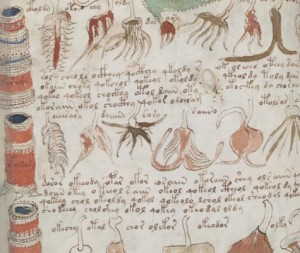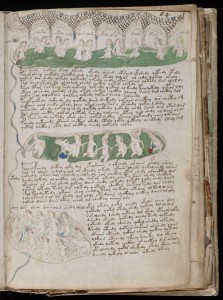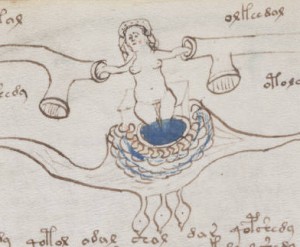Ever since I read Umberto Eco’s propulsive doorstopper, Foucault’s Pendulum, I’ve been mildly obsessed with secret–well, secret anything: societies, conspiracies, books. When it comes to the latter, there’s really no other book quite as secretive as the Voynich manuscript. The Voynich is a handwritten book thought to be written in the early 15th century–in top-secret code. A code, it’s turned out, that’s largely unbreakable. And many, many American and British World War I and World War II cryptographers–along with the occasional lovesick writer–have tried to break the code. None have succeeded.
But like any old book written in a language you can’t understand–like any kind of titillation, I suppose–the lure has a lot to do with the visuals. This is the case with the brilliant, eye-popping panoply of Henry Darger’s Vivian Girls, and it’s the case with the Voynich as well.
As in the Darger…
there is an intoxicating color palette at play in the field of the cyphers and cryptograms of the text. Almost seven hundred years later, the colors still look pretty vivid, right?

And who could pass up lots of naked ladies?

(This is a code, I presume, that doesn’t need to be broken.)
So what does everyone make of the Voynich? One of the common assumptions is that the book is some kind of medieval pharmacopoeia, but it could also be an astronomic guide or a biological text or… It could be anything–or everything. In a way, though, I think the most interesting way to view it is as the first interactive ebook. Sure, there’s no zoom and no scroll motion and no moving images, unless you drink some absinthe and blink your eyes really fast, but the geography the mysterious book seems to map strikes me as technologically adroit and futuristic. Not bad for an actual book.
Speaking of Eco, his controversial new novel drops this fall.



